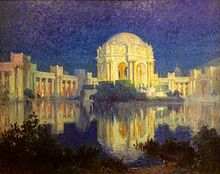使用者:Avit4799/沙盒
37°48′10″N 122°26′48″W / 37.80278°N 122.44667°W
藝術宮 | |
 2004年拍攝的藝術宮外景 | |
| 地點 | 里昂街3301號,舊金山,加州 |
|---|---|
| 占地面積 | 17英畝 |
| 建築師 | William Gladstone Merchant; Bernard Maybeck |
| NRHP編號 | 004000659[1] |
| NRHP收錄 | 2005年12月5日 |
藝術宮,位於加州舊金山市。這座建築是為巴拿馬太平洋萬國博覽會修建的,目的是在此展示美術作品。這座建築是那次萬國博覽會後少數被保存下來的建築之一,並且是唯一被保存在原址的建築。它在1965年被重建,但是對人工湖和走廊的整修,以及增加抗震加固設備,直到2009年初才完成。
藝術宮對於旅遊者和當地居民來說,到現在仍是一處著名的旅遊景點,也是舊金山灣區居民們舉行婚禮、拍攝婚紗照的常去地點。在阿納海姆的迪士尼加州冒險樂園中還有一個微縮版的藝術宮。[2]
歷史
[編輯]
藝術宮是巴拿馬太平洋萬國博覽會上十個重要的場館之一。[3]這座建築是由美國設計師伯納德·梅貝克設計的,他設計這座建築的靈感是從古希臘和古羅馬建築中得來的。[4] 大多數的展館在博覽會後都被拆掉了,但是藝術宮深受舊金山人的歡迎——甚至有一個舊金山人創立了一個保護藝術宮的團體——所以藝術宮得以保留到現在。[5]
For a time the Palace housed a continuous art exhibit, and during the Great Depression, W.P.A. artists were commissioned to replace the deteriorated Robert Reid murals on the ceiling of the rotunda. From 1934 to 1942 the exhibition hall was home to eighteen lighted tennis courts. During World War II it was requisitioned by the Army for storage of trucks and jeeps. At the end of the war, when the United Nations was created in San Francisco, limousines used by the world's statesmen came from a motor pool there. From 1947 on the hall was put to various uses: as a city Park Department warehouse; as a telephone book distribution center; as a flag and tent storage depot; and even as temporary Fire Department headquarters.[6]
While the Palace had been saved from demolition, its structure was not stable. Originally intended to only stand for the duration of the Exhibition, the colonnade and rotunda were not built of durable materials, and thus framed in wood and then covered with staff, a mixture of plaster and burlap-type fiber. As a result of the construction and vandalism, by the 1950s the simulated ruin was in fact a crumbling ruin.
In 1964 the original Palace was completely demolished, with only the steel structure of the exhibit hall left standing. The buildings were then reconstructed in permanent, light-weight, poured-in-place concrete, and steel I-beams were hoisted into place for the dome of the rotunda. All the decorations and sculpture were constructed anew. The only changes were the absence of the murals in the dome, two end pylons of the colonnade, and the original ornamentation of the exhibit hall.
In 1969 the former Exhibit Hall became home to the Exploratorium interactive museum, and in 1970 also became the home of the 1,000 seat Palace of Fine Arts Theater.[7]
Today, Australian eucalyptus trees fringe the eastern shore of the lagoon. Many forms of wildlife have made their home there including swans, ducks (particularly migrating fowl), geese, turtles, frogs, and raccoons.
設計
[編輯]Built around a small artificial lagoon, The Palace of Fine Arts is composed of a wide, 1100 foot pergola, an arch formed by rows of Corinthian columns framing a wide walkway, around a central rotunda situated by the water.[8] The lagoon was intended to echo those found in classical settings in Europe, where the expanse of water provides a mirror surface to reflect the grand buildings and an undisturbed vista to appreciate them from a distance.
Ornamentation includes Bruno Louis Zimm's three repeating panels around the entablature of the rotunda representing "The Struggle for the Beautiful" symbolizing Greek culture.[9] while Ulric Ellerhusen supplied the weeping women atop the colonnade[10] and the sculptured frieze and allegorical figures representing Contemplation, Wonderment and Meditation.[11][12]
The underside of the Palace rotunda's dome features eight large insets, which originally contained murals by Robert Reid. Four of the murals depicted the conception and birth of Art, "its commitment to the Earth, its progress and acceptance by the human intellect," and four depicted the "golds" of California (poppies, citrus fruits, metallic gold, and golden wheat).[13]
其他被保存下來的建築
[編輯]藝術宮並不是在博覽會後惟一被保留下來的建築。日本茶室(並不是1894年加州冬至國際博覽會中修建在金門公園里的的那個)在1915年時被收購,並被轉移到了加州的貝爾蒙,在那裡一直被保留到現在。[14]威斯康辛州和維吉尼亞州的展館被搬遷到了馬林縣。俄亥俄州展館被船運到聖馬特奧縣,在那裡一直保留到20世紀50年代。[4] 「進步之柱」在博覽會結束之後被保留了十年。但是之後為了保證濱海大道的交通通暢而拆除。舊金山市政禮堂也是在博覽會後被保留在原地的建築,但是它不是在展覽場地內修建的,1992年10月13日,它被以一年前墜機身亡的搖滾音樂會經紀人比爾·格雷厄姆(Bill Graham)重新命名為比爾·格雷厄姆市政禮堂。
圖集
[編輯]-
1915年的藝術宮
-
白天的藝術宮和水裡的倒影
-
柱廊
-
從內部向外的視角
-
藝術宮和人工湖
-
藝術宮和噴泉
在大眾文化中
[編輯]藝術宮外面的人工湖以及其穹頂經常被用來作為背景出現。
在電影中
[編輯]- 迷魂記 (1958)
- 一次又一次 (1979)
- 鋸齒邊緣 (1985)
- Kuffs (1992)
- 我嫁給了一個斧兇手 (1993)
- 勇闖奪命島 (1996)
- 另一個姐妹 (1999)
- 單身漢 (1999)
- 房間 (2003)
- 雙絞線 (2004)
在電視節目中
[編輯]在電子遊戲中
[編輯]在小說中
[編輯]參見
[編輯]
參考資料
[編輯]- ^ National Register Information System. National Register of Historic Places. National Park Service. 2009-03-13.
- ^ Golden Dreams. Disney's California Adventure. Walt Disney Company. [2007-05-11]. (原始內容存檔於2007-04-06).
- ^ The Virtual Museum of the City of San Francisco: Panama-Pacific International Exposition, San Francisco, 1915
- ^ 4.0 4.1 McCoy, Esther. Five California Architects. New York: Reinhold Publishing Corporation. 1960: 6. ASIN B000I3Z52W. 引用錯誤:帶有name屬性「mccoy」的
<ref>標籤用不同內容定義了多次 - ^ The Palace of Fine Arts: A Short History
- ^ The Palace of Fine Arts: Rebuilding
- ^ Palace of Fine Arts, Official Website, background
- ^ A Treasury of World's Fair Art & Architecture: Palace of Fine Arts
- ^ Palace of Fine Arts, San Francisco Marina Neighborhood
- ^ The Architecture and Landscape Gardening of the Exposition, A Pictorial Survey of the Most Beautiful Architectural Compositions of the Panama-Pacific International Exposition by Louis Christian Mullgardt
- ^ Exhibition of American Sculpture Catalogue, 156th Street of Broadway New York, The National Sculpture Society 1923 p.55
- ^ Macomber, Ben. The Palace of Fine Arts and its Exhibit, With the Awards. The Jewel City: Its Planning and Achievement; Its Architecture, Sculpture, Symbolism, and Music; Its Gardens, Palaces, and Exhibits. San Francisco and Tacoma: John H. Williams, Publisher. 1915.
- ^ The Art of the Exposition by Eugen Neuhaus
- ^ History of The Vans restaurant
- ^ Carman, John. Letterman's Guest List. Hearst Communications Inc. [7 June 2011].






